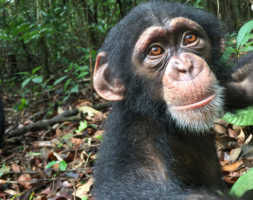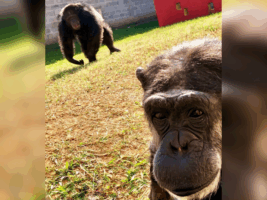Book review – “Chimpanzee”: lessons from our sister species

Chimpanzee is a wonderfully comprehensive book. Kevin D. Hunt is Professor of Animal Behaviour and Anthropology at Indiana University, Bloomington. He is a functional morphologist, using reverse engineering to consider how the anatomical structures of animals, in this case chimpanzees, function in their everyday lives. He then theorises about which environmental pressures have determined their physical and mental attributes and moulded chimpanzee behaviours. This approach explains how rooted chimpanzees are in their homelands: “I imagined a sort of chimpanzee-mist rising out of the soil and coalescing into the individual in front of me.”
As would be expected, the book is full of scientific detail covering mechanics, physiology, psychology, and individual and social behaviours – and not just of chimpanzees, but of monkeys and other apes – including humans. Hunt is not only a theoretical scientist; he has done fieldwork at chimpanzee research sites like Gombe, and he is founder and director of the Semliki Chimpanzee Project, whose fieldwork is done at the Toro-Semliki Wildlife Reserve, Uganda. He finds in the wild, chimpanzee “excellent memories, superbly tuned sense of geographical space, social subtlety and intense mother-infant bonds closely match human intelligence.”
Chimpanzee is full of colourful anecdotes, both from field observations and from experiences with chimpanzees in captivity. It is written in a style that is not too daunting for the non-scientist, yet I am sure would keep the scientist engaged. His descriptions of chimpanzee social dynamics are vivid – explaining that, due to their community dispersal over large areas when searching for food, many, if not most, significant community events happen outside any one individual’s sight or hearing – therefore, chimpanzees live in ‘virtual’ societies: “The chimpanzee community is a mental construct.”
Hunt’s explanation of the wide range of tool use across the various chimpanzee cultures, and the chimpanzees’ extraordinary “distance-minimizing abilities that require the possession of sophisticated mental mapping skills, indistinguishable, in fact, from those of humans” are fascinating. As is their ability to calculate quantities (e.g., fruits in trees) in a fraction of the time it would take a human, and to pick up on social dynamics (e.g., entering a group they haven’t been with for a while and noticing what has changed) in a fraction of a second.
“They are like us not because they mimic us, but because they are a close relative, a sister species”, their senses are so like ours that Hunt suggests that if we were to see, touch, taste, smell, or hear the world through their senses we would “hardly notice” the difference. We would certainly recognise their ability to deceive one another, and to support one another. Hunt goes through the historical misconceptions about chimpanzees, usually concerning what separates them from humans, and relates how one by one they were disproved. Including the use of language: “I find the arguments of those who contend that apes lack language to be strained and unconvincing.”
“Chimpanzees in the wild … move with efficiency and purpose. They are the essence of competence.” Hunt is an enthusiastic chimpanzee advocate, terming them “literally superhuman”. Beyond their physical attributes, “they are astonishingly intelligent. Chimpanzees are a natural wonder.” And he doesn’t over-glamorise the task of a chimp researcher: “12 hours and 50 minutes of a 13-hour day is taken up with your research target moving slowly and quietly through the forest, chewing, grunting now and then, passing gas, and staring into space.”
Chimpanzee is a large book, and I could go on and on about the things I learnt as I read it. “Chimpanzees are not wanna-be humans. Instead, they are just as evolved as humans – though in a different direction”. I really liked the even-handed attention given to both female and male community dynamics. The female use of land and their social relations are described, and the effects of these on how males deal with territory, and with each other. I was also intrigued by Hunt’s description of hierarchy as another ‘virtual’ aspect of their society, and liked his observation that “there is a rudimentary ethical component to their culture”.
Chimpanzee is informative, funny, well-illustrated, and I can’t recommend it highly enough to those who are interested in our “sister species”. As Hunt finishes his book: Pan in sempiternum! Long live chimpanzees!
Cambridge University Press: 2020. ISBN: 9781107544413
* Alyson Baker lives in Whakatū Nelson, Aotearoa New Zealand. She volunteered at the Ngamba Island Chimpanzee Sanctuary, Uganda in 2017, and returned in 2018 when she also went chimp tracking in Kibale National Park. Alyson is planning on going back to Ngamba this year, after a planned trip in 2020 was cancelled due to Covid-19. In 2021 Alyson completed an MA looking at our moral responsibilities to chimpanzees and she is currently working on a PhD regarding moral motivation and working on behalf of chimpanzees.

 Español
Español
 Português
Português








